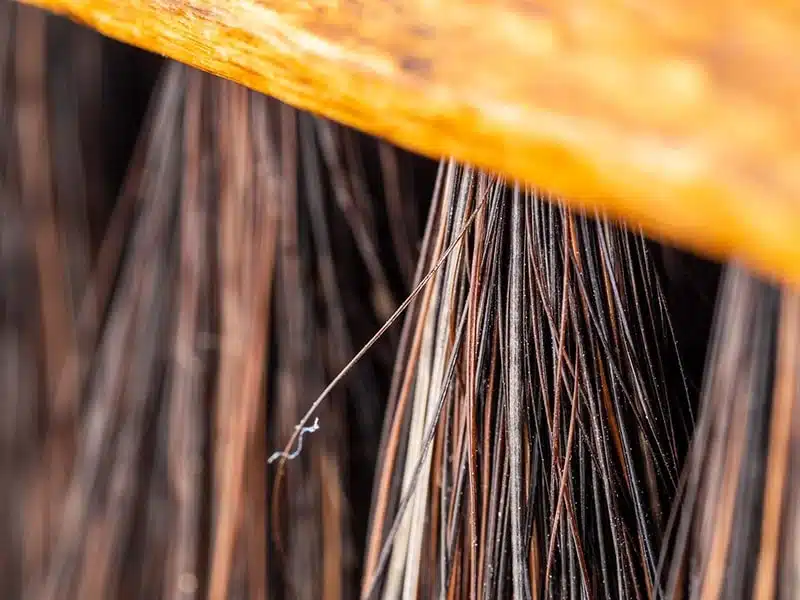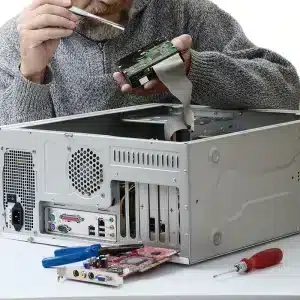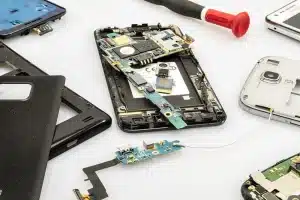Electrical products like circuit boards are commonly utilised in many electronic devices, including industrial equipment, computers and alike. As expected with time, deterioration of these electronic devices will occur, particularly as dust, grime and water comes into contact with the device. These contaminants can build-up to a point where action must be taken in order to prevent irreparable damage to the device. Fortunately, there are several preventative steps you can take to care for your electronic devices. One of these measures, which we will talk about in this article, is using cleaning tools such as an ESD brush to mitigate component deterioration and ESD damage.
Our guide below will discuss all ESD brushes, their importance and their various uses.
In an Electrostatic Protected Area (EPA), you will usually find that products are cleaned by brushing or by blowing using a compressed gas. So how does an ESD brush differ from a regular cleaning brush?
An ESD brush is a type of brush that has been specifically developed to be used in static control environments, meeting the IEC-61340-1-5 International Standard. They have been made to meet the specific needs of the electronics industry where electrostatic charge or build-up are detrimental to the manufacturing process. Their ESD-safe properties distinguish them from non-ESD-safe brushes, which shouldn’t be used for static sensitive electronics to avoid any possible ESD damage. They are usually made from horsehair or nylon bristles with either a wooden or conductive polypropylene handle.
An ESD brush should be used for cleaning, dusting or removing dust particles or solder debris from delicate electronic components such as integrated circuits and printed circuit boards, without generating any static charge. This makes ESD brushes an essential component in a static controlled area.
Dust, dirt or solder accumulation is one of the most common occurrences around an electrical component. Electrical charges can accumulate at any stage of electronics production, from manufacturing, handling and assembly of the device to testing and finally shipping the product. Without safety measures in place, these charges can cause damage to static sensitive components. This is why ESD control products, such as an ESD brush, are necessary for industries that handle electronics.
Gently using a soft bristled, small brush, such as a horsehair wooden brush or conductive brush, can safely remove contaminants without affecting the components or their electrical properties. Using an ESD brush for cleaning your components or devices helps ensure that they don’t deteriorate over time due to ESD damage. These brushes help preserve electronic devices’ quality, reliability and functionality. There are of course limitations as to how far even the smallest brush can reach, for example underneath the component. Even so, using an ESD brush is very effective in reducing the likelihood that devices will malfunction.
ESD brushes are also an essential tool to use before the soldering process, helping to improve the soldering operation. Using an ESD brush before soldering can help to remove any small particles or other debris from the electronic component. By doing this, not only do ESD brushes help make the soldering process on electronic parts easier to handle, but it also helps with the cleanliness (i.e. excess flux and solder on solder points of electronics).
Without cleaning or removing contaminants such as leftover residue or dust from these electronic devices, the device could degrade and therefore not function correctly. It is crucial that devices are regularly cleaned with the use of an ESD brush to prevent damage and improve longevity.
For instance, let’s imagine a computer power supply unit. If dust were to build-up overtime inside of the unit and no cleaning action has been taken, the dust can impact the computer’s performance in two ways. One: the components of the computer will retain heat. Two: It makes it harder for the internal fans to dissipate the heat from the system. Therefore, the computer’s efficiency is decreased.
Using regular brushes for cleaning electrical components (i.e. printed circuit boards or integrated circuits) should be avoided at all costs. The reason being, a regular brush is composed of high charging insulative materials such as plastic which can generate a substantial amount of static charge. When sweeping the brush over an electrical component, tribocharging takes into effect due to the contact and separation of the brush bristles on the component. This electrostatic charge can discharge onto the product, possibly causing irreversible ESD damage. Often, the damage will not be discovered until the product has been shipped to the customer – particularly if the damage is latent. This poses an inconvenience for the manufacturer as production time and load is increased with an incur of costs.
Often, it can be misunderstood that a regular brush can be used for cleaning components as long as the operator is fully grounded via an Earthing system. It must be noted that, even if the operator is fully grounded, the electrostatic charge will remain on the brush’s fibres and handle. Therefore, posing a threat to the static sensitive product.
Since brushes are used in close contact with critical electrical products, it is paramount a conductive and/or static dissipative brush is used.

Any ESD-safe work environment will benefit from having ESD brushes as part of its static control toolkit. So what are the essential features of an ESD-safe brush?
As for any hand tool used within an Electrostatic Protected Area (EPA), the handle of the tool must not be made from an insulative material. This is because the material will prevent the path-to-ground to the hand of the grounded operator. Any static charge present on the tool can discharge onto a product and cause damage to the static sensitive device. There have been instances in the electronics industry where there have been product failures. For instance, where an operator has brushed a circuit board after soldering with an insulative nylon brush. So what type of materials should you look for when selecting a brush to use on your components?
Firstly, all parts of the brush must be conductive or static-dissipative. This applies to both the bristles and the handle of the brush. The handles of the brush are permanently bonded to the static dissipative bristles. This is to allow for a quick and controlled discharge of static electricity through the Earthed operative’s hand. Common materials used for creating the handle of the brush include strong conductive polypropylene, aluminum, zinc-plated steel and static-neutral wood. As for the bristles, these tend to be derived from animal hair (such as horse hair) or conductive nylon fibres to allow for static dissipation.
The brush as a whole should be able to effectively dissipate static charges so that electronic components will not be damaged. Ideally, the bristles on the brush should be firm since these are the bristles that are best for cleaning electronic devices. It’s also ideal to choose an ESD-safe brush with ergonomic handles so that individuals cleaning electronic components can be comfortable while using the brush for a prolonged period of time.
A synthetic type of bristle, nylon is tough and durable. Bristles made from this material do not harbour bacteria and are resistant to most acids. Its particular perk is it does not shed. It also won’t scratch most surfaces. Brushes with nylon bristles offer excellent scrubbing and cleaning performance.
Hog bristles offer excellent resilience. A brush with this type of bristle is ideal for handling sticky or viscous materials.
Goat hair bristles are extremely soft and fine. They are ideal for cleaning and polishing.
Horsehair bristles are soft and long-lasting. Brushes with this type of bristle are effective in dusting, sweeping and general cleaning of electrical components.

Your choice of brush can affect how well the electronic component is cleaned. As many electrical components such as transistors and circuits are getting smaller and smaller due to technological advancements, it is important that you select a brush that has soft bristles and has the ability to reach into small crevices. This will enable the efficient removal of any stubborn dirt, abrasion and residue.
There are different types of brushes for different applications. There are conductive and static-dissipative brushes. There are brushes with bristles made from goat hair, hog hair and horsehair. And there are brushes specifically designed for cleanrooms.
ESD brushes with conductive and static-dissipative properties are safe to use in a dry environment. Conductive brush handles have a typical surface resistivity between 10^(4) and 10^(6) while dissipative bristle fibres have a typical surface resistivity between 10^(6) and 10^(8). You can use them when trying to eliminate static build-up from your work surface. They are typically used in conjunction with a wrist strap or some other means that offers a reliable path to the ground.
Meanwhile, brushes with bristles made from hog hair, goat hair and horsehair are essentially static-neutral. On the other hand, cleanroom brushes are designed to be heat-resistant and can be autoclaved.
While the type of bristle and handle material is important to consider, the size and style of the brush is equally important.
An ESD Nail Brush is often opted for if scrubbing is required. The handle is designed to provide a good grip for ease of brushing.
For cleaning hard-to-reach places or small components like transistors and resistors, a short-handled, densely packed, hard bristled brush is recommended to use. Often, you can find dual-sided brushes with a flat trim bristle at one end and on the other a hard chiseled trim. These are great for multi-purpose use, particularly for reaching into crevices and scrubbing PCBs (i.e. SMD assembly).
Long-handled, wooden brushes with soft horsehair bristles are usually used for cleaning optics, disc drives and other electrical assemblies. The long handle allows for ease when cleaning particle contaminants and residue from ESD sensitive products. The horsehair bristles are durable and soft which makes them a suitable choice for scratch-free, dry brushing and polishing. This type of brush is not resistant to acids or alkalis.
A brush set is a desirable choice particularly if you require various brushes for different purposes. For example, the brush set in the image above features a short-handled, small bristle brush, a paintbrush style brush, a comb-like style brush and a general toothbrush style brush. An affordable option and great for multi-purpose use: from cleaning microelectronics to larger printed circuit boards.
The type of brush you select should depend on the type of work you will perform. So before you use just any brush, you must first determine what kind of brush is most appropriate for your specific application.
An ESD-safe brush can be used in multiple settings. Here are some various uses of an anti-static brush or ESD brush.
ESD-safe brushes are used to remove any existing static charge and clean many different types of electronic components.
Removing flux from PCBs: Flux removal is important to prevent low voltage insulation short. Using an ESD brush can help you safely and thoroughly remove residue after the soldering process is done.
Removing dirt and dust: Electronics are less vulnerable to damage if they are free of dirt and dust. Keeping them clean helps prolong their lifespan.
Prepping before soldering: An ESD-safe brush helps remove small particles and other debris from electronic components before you proceed with soldering. Any grease or dirt left on the metal can impact the soldering process.
Cleaning work surfaces: Using an ESD-safe brush can help you thoroughly clean anti-static mats and other areas in your workstation.
Other ESD brush applications include the following:


There are numerous ESD-safe brushes to choose from, depending on the task you’ll be performing.
Bondline offers a comprehensive range of brushes that you can use for static-free cleaning and other applications. From double-ended applicator brushes and nail brushes to upright and toothbrush style brushes, our ESD brushes come in various styles and sizes. We also offer a handy ESD brush set.
Get the right ESD brush for the job. View our ESD brush catalogue here.
If you have any queries you would like to ask us, please don’t hesitate to call us on 01793 511000 or email us at sales@bondline.co.uk. We’re always happy to help!
Fields marked with an * are required
On selected products if ordered before 1pm
Dedicated account manager to help your ordering process
Great value on premium quality products
Bondline Electronics Ltd are a leading manufacturer and supplier of static control products within the ESD industry. Products such as Flexible and Rigid Packaging, Bench Matting, Wrist Straps, Heel Grounders and Shoes, ESD Protective Clothing and Gloves, Test and Measurement Equipment along with many storage and handling solutions.
Bondline products are all qualified and compliant according to IEC-61340-5-1 International Standard.
Registered Company Number: 02933918
Office Hours: Mon – Thurs: 9am – 5pm Fri: 9am – 2pm

Bondline Electronics Ltd are a leading manufacturer and supplier of static control products within the ESD industry. Products such as Flexible and Rigid Packaging, Bench Matting, Wrist Straps, Heel Grounders and Shoes, ESD Protective Clothing and Gloves, Test and Measurement Equipment along with many storage and handling solutions.
Some of these cookies are essential, while others help us to improve your experience by providing insights into how the site is being used.
For more information and to read more about our privacy policy, please visit our Privacy Policy
Necessary cookies enable core functionality. The website cannot function properly without these cookies, and can only be disabled by changing your browser preferences.